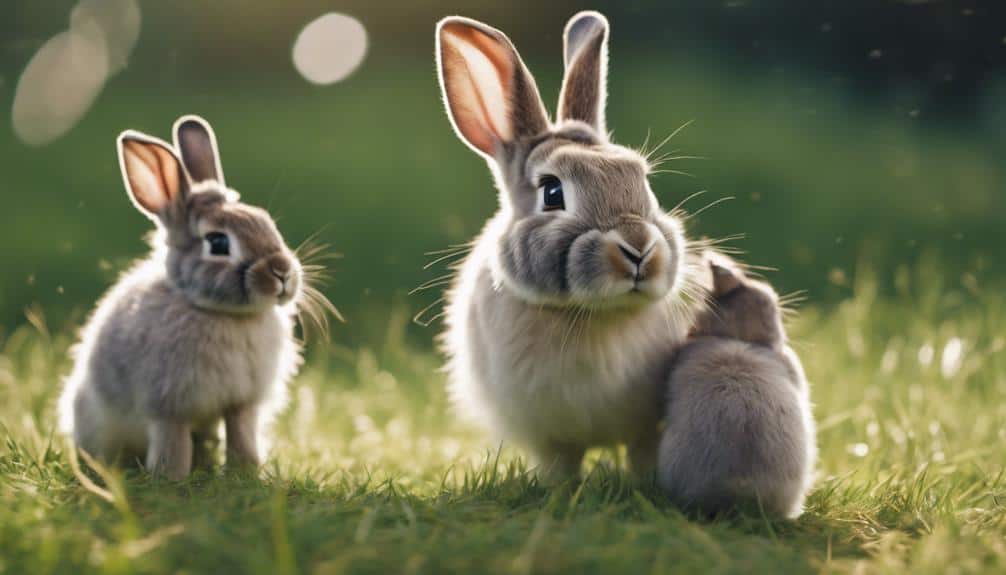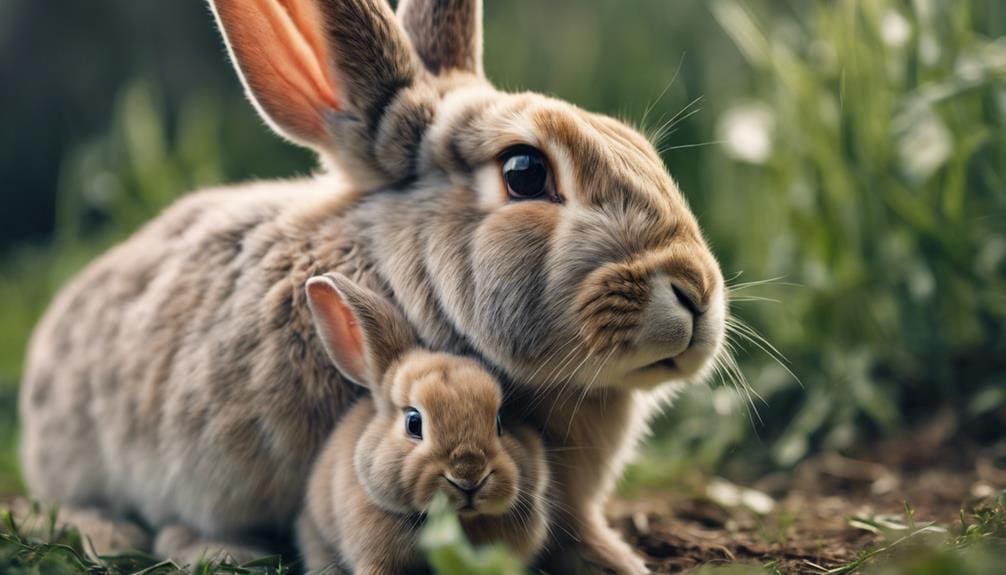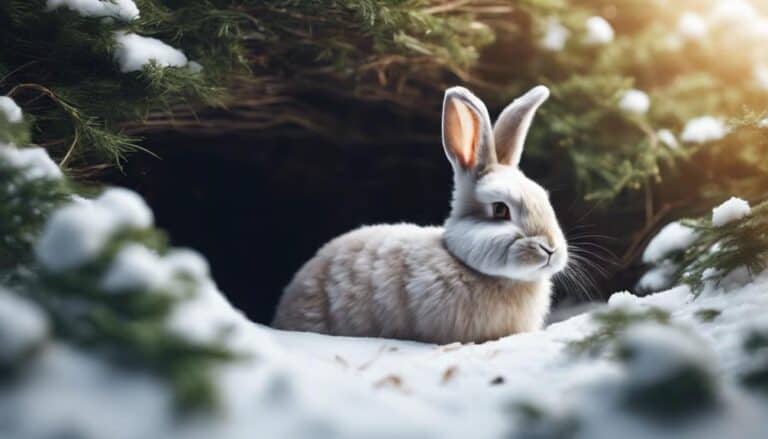When bunnies need to move their babies, they gently nudge and carry them to keep them safe from harm. It's just their natural way of protecting their little ones. Mother rabbits will relocate their nests every now and then to avoid predators. They'll pick safe spots and carry each baby in their mouth to their new home. By moving the nest, they lower the chances of predators finding the babies.
To make sure baby bunnies stay safe, mother rabbits hide their nests well and limit their visits. They also change the nest's location strategically to confuse any potential predators. This protective behavior is super important for the babies' survival. Bunnies have their ways of looking out for their babies and keeping them out of harm's way.
Contents
Key Takeaways
Bunnies move their babies by gently nudging and adjusting them to keep them safe. They make sure the little ones are cozy and secure in their nest. Mother rabbits also relocate their nests from time to time to avoid predators. During these moves, the mother carefully carries each baby in her mouth to protect them.
They choose hidden spots for their nests to shield their offspring from any potential harm. Mother bunnies limit their visits to the nest to ensure the babies' security. This also helps them attract potential mates to ensure the safety and well-being of their young ones.
Bunny Transport Mechanism

Bunnies move their babies by nudging and adjusting them, rather than carrying them in their mouths. This helps keep the babies safe and prevents injuries. Mother rabbits use their noses to gently guide the bunnies to where they need to be, ensuring their well-being.
To protect their young, mother rabbits relocate the nest periodically to avoid attracting predators. They carefully choose nesting materials like grass, fur, and leaves to keep the babies warm and hidden. By moving the nest and minimizing visits, mother rabbits reduce the risk of predators finding the babies.
If you find a baby bunny and think it needs help, it's best to contact a wildlife rehabilitator. Moving or caring for the bunny without proper knowledge can harm it. Seek professional assistance to ensure the baby bunny receives the care it needs.
Maternal Bunny Behavior
Mother rabbits take great care to keep their babies safe. They carefully hide their little ones in well-hidden nests, making sure they're out of sight from any predators. This is super important because it helps the baby rabbits stay safe and avoid any danger.
These momma rabbits are super attentive. They visit their babies once a day to feed and clean them. By not visiting the nest too often, they're actually protecting their babies from harm. This way, they reduce the chances of attracting any predators to the nest and make sure their vulnerable babies stay safe and sound.
Bunny Nest Relocation

Mother rabbits move their babies to a new nest when they sense danger nearby. This helps keep the little ones safe from harm. The mom carefully picks a new spot for the nest, making sure it's cozy and secure.
She carries each baby in her mouth to the new nest, one by one. This way, she can protect them during the move. It's a natural instinct for mother rabbits to safeguard their babies in the wild.
Ensuring Bunny Baby Safety
If you're wondering how mother rabbits keep their baby bunnies safe, here's the scoop. These smart mamas carefully pick hidden spots for their nests and only visit once a day. This way, they lower the chances of predators finding the babies. Mama rabbit pops in quickly to feed and clean the little ones, then she's out to avoid any trouble. This routine not only protects the babies from predators but also keeps pesky humans at bay.
To add an extra layer of security, mother rabbits switch up the nest spots often. This confuses any potential threats lurking around, making it tough for predators to locate the vulnerable babies. With this sneaky nest strategy, rabbits do a great job of shielding their offspring.
It's all about striking a balance between caring for the babies and reducing risks, showing how devoted mother rabbits are to keeping their precious little ones safe and sound.
Mother Bunny Protective Instinct

Mother bunnies protect their babies by finding hidden nests and only checking on them once a day. This protective behavior is all about keeping their little ones safe from any dangers out there. They're smart about it too, always changing up where they hide the nest to keep it extra safe.
The momma bunny's job is to feed and clean her babies before leaving them to rest in a cozy spot. She doesn't visit too often to make sure the babies stay safe, as going back and forth could draw unwanted attention. By being careful with nest locations and limiting visits, mother bunnies make sure their babies are secure and also attract potential mates for the future. It's all about striking a balance between caring for their young and staying hidden to protect them.
Frequently Asked Questions
Can Mother Rabbits Move Their Babies?
Yes, mother rabbits can totally move their babies if they need to. It's all part of their natural instinct to take care of their little ones. But moving them can be a bit tricky. The mama rabbit's protective instincts kick in to make sure her babies stay safe during the move. And those nesting materials they use help strengthen the bond between the mom and her babies, showing just how caring and nurturing she is.
Can You Safely Move Baby Bunnies?
When you need to move baby bunnies, remember that their mom knows what's best. To keep them safe, handle them carefully, talk to a vet if needed, and think about moving their nest. Trust the bunny parents' instincts and be cautious.
How Long Can Baby Bunnies Survive Without Their Mother?
Without their mom, baby bunnies can make it on their own for about 24-48 hours. During this time, they rely on their natural instincts to survive. This period is super important for things like eating, bonding, staying warm, getting care, and learning to be more independent.
How Long Does It Take a Rabbit to Push Out a Baby?
When a rabbit is giving birth, each baby usually comes out pretty quickly, with a new little bunny arriving every 10-30 minutes. This quick delivery time shows how efficient the rabbit is at pushing out the babies during labor. So, if you're watching a bunny give birth, you can expect to see newborns popping out one after the other in a swift process.
Conclusion
The mother bunny carries her babies in her mouth as she hops through the meadow, making sure they're safe with each gentle step. She keeps a close eye on them and guides them carefully, like a conductor leading a delicate orchestra.
The bond between the mother and her babies is strong, creating a beautiful dance of love and protection in the wild.






